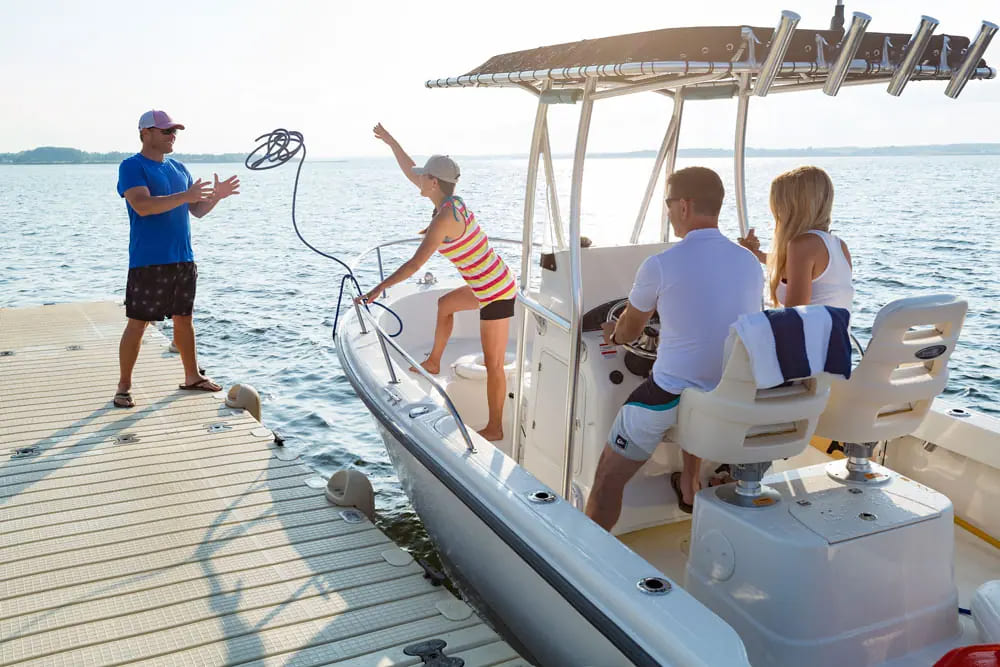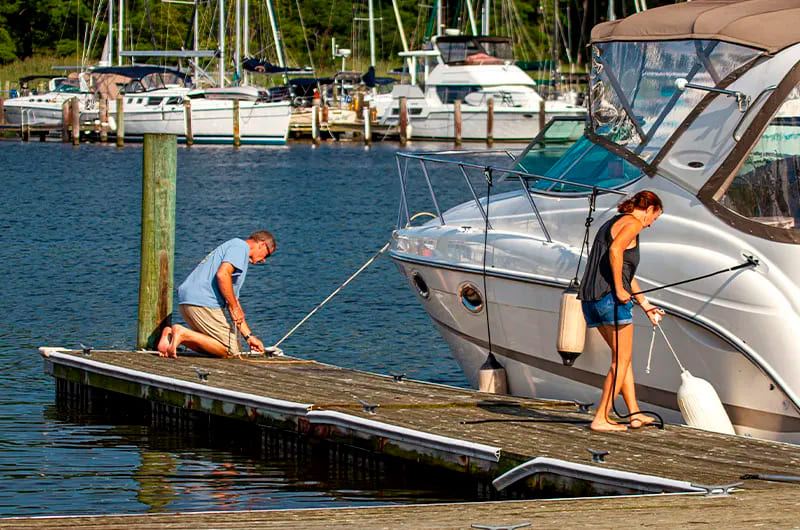Seeking an idyllic getaway in your boat? Learn boat docking to enjoy serenity in your free time on a docked boat. If we discuss the process of boat docking, it is simply securing the vessel to the dock. You can tie the boat and relax with your family and friends in an ideal yacht. However, just like boat mooring, it is worth mentioning that the docking process also entails some essential steps to make the whole process easier. This article guide will discuss the process of docking a vessel efficiently even for newbies. So, without further ado, let’s get into the guide.

What is Boat Docking?
The technique of securely fastening a boat to a dock or floating dock is known as boat docking. This includes tying the boat to the dock so that it stays stable, using a cleat hitch or clove hitch knots. In addition, it includes complying with boat dock rules and regulations, which include approaching at a safe distance and speed. But, things like using boat lifts or a storage facility for upkeep and preservation, as well as boat dock covers for weather protection, must be taken into account. Gaining expertise in docking techniques is essential for operating boats safely and effectively, which guarantees fun times on the water.

Effective Docking Techniques and Tips
Tying the boat to the dock can be a little perplexing if you are a new boater but with the right boat dock ideas, you can master this process. This section of the article is focused on how to dock a boat perfectly for a relaxed get-together.
1. Make a Plan for Boat Docking
- Assess Conditions: Consider wind, current, and obstructions such as boat dock poles before docking.
- Select Method: Figure out the optimal angle, taking into account wind direction and other vessels.
- Utilize Techniques: Depending on the situation, choose whether to use spring lines, stern lines, or both.
- Set Up the Crew: Designate responsibilities for line handling and efficient communication.
- Remain Confident: Don’t be scared about altering plans in the event that unforeseen circumstances arise.
- Use Backup Plans: Make backup plans in case your first strategy doesn’t work.
- Stay Alert: In addition, keep an eye out for any changes as you approach.
- Reassess as Needed: Be prepared, though, to review and change your plan of action as needed.
2. Approach Gradually
- To enable greater control, gradually slow down as you get closer to the floating dock or boat storage area.
- To keep your pace constant without making abrupt accelerations, use small throttle adjustments.
- Pay attention to any side of the boat obstructions or other boats, and modify your speed accordingly.
- Keep a safe distance from the dock, particularly in congested areas, to prevent collisions.
- But be aware that wind or currents could change the direction and need making more changes.
- As you prepare your approach, take visibility and maneuverability into account.
- In addition, maintain awareness of your surroundings and be ready to adjust as necessary to ensure seamless docking.
3: Use Proper Trim for Boat Docking
- It’s important to adjust your boat’s trim for the best possible handling and agility, especially while approaching a lake dock.
- Maintaining stability and control through proper trim enables safer operations in the vicinity of dock posts and dock cleats and enables smoother docking movements.
- You can prevent unexpected movements by adjusting the trim to guarantee that the boat’s bowline knot stays firmly tied to the cleat or post.
- Additionally, adjusting the trim can affect how responsive the boat is to steering inputs, allowing more accurate maneuvering in tight spaces.
- Finding the perfect trim balance is important for maintaining the boat’s stability and performance in a variety of marine environments.
- To further improve stability and security during docking procedures, dock lines can be secured using knots such as the clove hitch.
- All things considered, learning appropriate trim steps is essential for handling a boat safely and effectively, particularly when docking at a lake pier.
4: Assign Roles
For a boat docking to go smoothly, roles must be assigned.
- Captain: In charge of overall docking process coordination and decision-making. They use their knowledge of boat docking ideas to supervise the process and offer advice as required.
- Deckhands: Help with line handling, fenders deployment, and communication with the captain. They should know the specifics of securing the boat in a slip and be skilled at tying boat dock knots.
- Observer: Keeps an eye out for anything that might be in the way, other ships, or shifting weather patterns. They are essential to guaranteeing the safety of the docking operation by giving the captain important information.
Each member should also be well-versed in the dock system and well-aware of their roles. However, versatility is essential, and depending on the particulars of each docking scenario, roles could need to be changed.
5: Communicate Clearly
- Effective communication is essential for docking a boat safely.
- Make sure that everyone is aware of their responsibilities when utilizing a drive–on boat lift.
- Assign someone to operate the side of the boat driver’s guidance.
- Make good use of hand gestures and spoken instructions when communicating.
- Make sure that everyone knows how to avoid boat dock poles.
- Additionally, pay attention to nearby obstructions and other vessels.
- But even in trying circumstances, maintain your composure and attention.
- A smooth docking operation is ensured and the risk of accidents is decreased with clear communication.
6: Use Fenders and Dock Lines for Boat Docking
- To prevent damage to the boat when docking, fenders are inflatable pads or bumpers positioned along the side of the boat.
- They absorb impacts that come from the boat hitting boat dock poles or other objects.
- The ropes used to fasten the boat to the mooring or dock are called dock lines.
- To keep them from drifting, they are fastened to the dock and cleats on the boat.
- Furthermore, dock lines and fenders are necessary for secure docking operations.
- In addition, they offer security and comfort when docking in different circumstances.
- Nonetheless, for adequate security and protection, dock lines and fenders must be positioned and adjusted correctly.
7: Practice Different Boat Docking Techniques
You can practice different techniques and opt for the most suitable one.
Below are some of the techniques which you can practice to make yourself professional in this technique:
Parallel Docking
- Bring the boat up parallel to the dock and position it alongside.
- Use lines to secure your boat, and abide by the laws when it comes to boat docking.
- Ideal in tight spaces or with strong currents and winds.
Perpendicular Docking
- Make your approach to the dock at a 90–degree angle before making a sudden turn to come alongside.
- To keep the boat stable and safe, use fenders and lines.
- Ideal for docks with little space or in favorable wind and current conditions.
Med Mooring
- Using lines, secure the boat at the bow and stern.
- Make sure to follow boat dock laws and leave enough space between vessels at the dock.
- Perfect for locations with just a little dock space or for long-term stays.
Methods of Docking Boats for Storage
- Make use of the right techniques according to the conditions and available area.
- When storing boats, cover them with boat dock covers.
- When it comes to easy maintenance and storage, think about using boat lifts.
Innovative Designs for Boat Docking
- Explore new methods like remote-controlled docking devices.
- Install cameras or sensors for improved control and visibility.
However, if you want to know more about a boat’s handling characteristics, check out this blog.
Try out these methods and learn to dock a boat.
Conclusion
Wrapping up, this article covered bot docking tips and techniques to secure the vessel. You can learn different tips and enjoy an idyllic time with your family and friends on a safely secured boat.
Dock Like a Pro, Go with the Flow!

